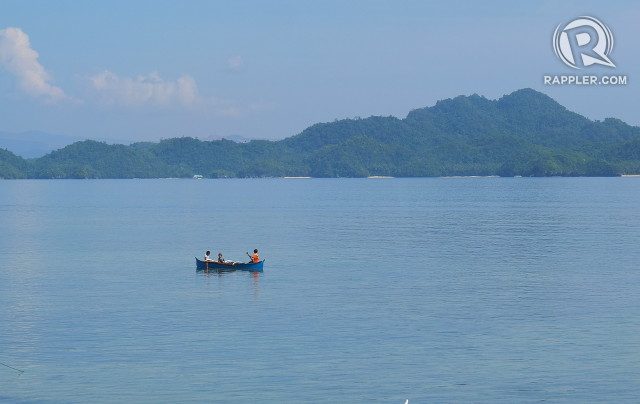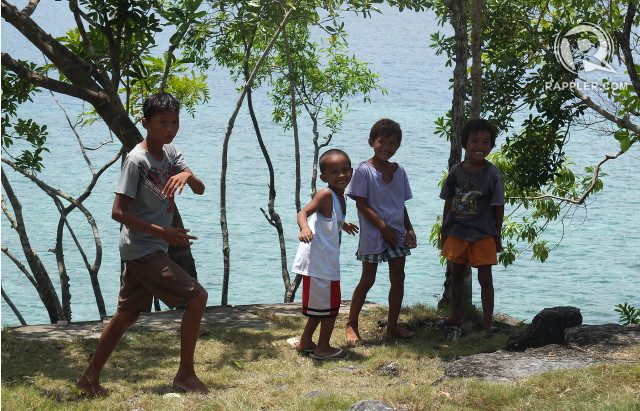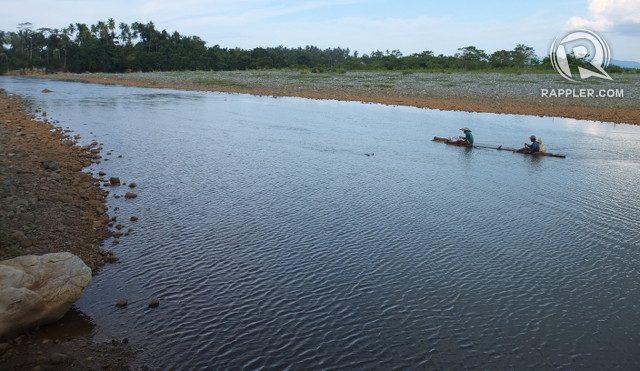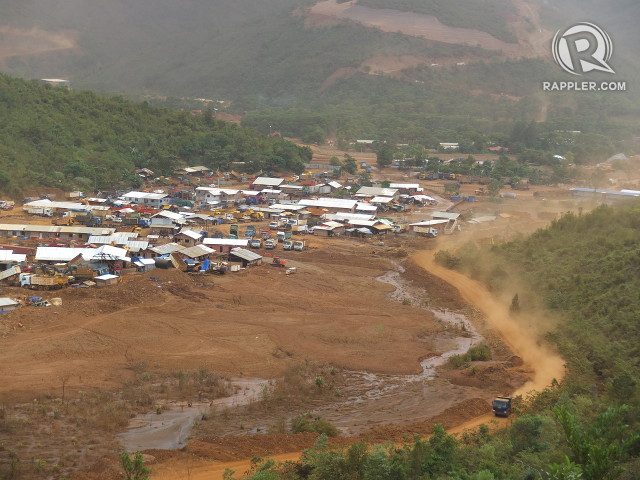SUMMARY
This is AI generated summarization, which may have errors. For context, always refer to the full article.

CANTILAN, Philippines – On an islet of stone crowned by grass and a fence of trees, the fisherfolk of General Island stand guard over their marine protected area – their source of life and livelihood.
On the clear July afternoon of my visit, it seems their foe is imaginary.
Surrounded by dazzling waters off the coast of Surigao del Sur, the fishers are carefree. Children chase each other on the grass, mothers hold their babies to their breast, enjoying the breeze.
But come December, the start of the rainy season for this part of Mindanao, the waters around the islet turn coffee-brown.
The source of this malevolent discoloration, say the fishers, are the mines in nearby towns Carrascal and Cantilan, both operated by nickel mining company Marcventures Mining and Development Corporation (MMDC).
“Pag malakas ang ulan, hindi na namin makita ang sanctuary namin. Umaabot dito yung galing sa minahan. Kulay parang kape, yung 3-in-1,” said Eustaquio “Jojo” Juralbar Jr, the president of the fisherfolk organization, ISLAMDUNK.
(When the rain is heavy, we no longer see our sanctuary. The discharge from the mines reaches this place. It looks like coffee, like 3-in-1 coffee.)
Juralbar, sitting in a concrete shed the fishers have built on the islet, squinted toward a hill on the mainland. The hill has been taken over by a gaping wound lined by tan soil. Below, trucks and tractors are at work like ants.
The tan wound stretches down toward the coast, beyond which wait dozens of large ships that carry the precious mineral-rich soil to countries like China.
Coffee-colored water oozes from the hill’s wound like blood. On summer days, it doesn’t appear to stray far from the mine. But it’s not hard to imagine it reaching farther, carried by the rains of December to February.
Menace in the water
The coffee water reaches the coral reefs of General Island’s marine sanctuary, covering them in the fine sediment from the mine, said Juralbar.
“It affects our corals. They are gone, they are destroyed. They are not able to recover,” he continued.
His observation has evidence in science.
Siltation or land runoff is one of the gravest threats to corals, according to studies. Fine silt clouds ocean water, reducing the amount of light that reaches corals.
Without enough light, the algae in corals are not able to photosynthesize. This cuts the coral’s supply of nutrients which eventually leads to coral death.

A dive into the marine sanctuary revealed as much. Though there were still colorful fish flitting about, only white skeletal remains of corals were left. Far from looking like a sanctuary, it looked like the remnants of a besieged kingdom.
Coral reefs are habitat of fish which the fishermen need in abundance to make a decent living.
“May mga isda pa rin pero hindi na kasing dami ng dati (There are still fish but not as much as before),” said Juralbar.
For this reason, the fishermen oppose the mining activities. Together with other concerned citizens of Cantilan, they filed a complaint against MMDC for environmental harm caused by lack of protective measures in their operations.
In April 2014, the fishers won a temporary victory.
The government’s Mines and Geosciences Bureau (MGB) closed the Cantilan and Carrascal mines for failure to maintain environmental mitigation measures.
Then it flooded, I wasn’t able to earn it back. I haven’t earned anything back until now.
– Anna Mae Licu, farmer
But the suspension order was lifted from the Cantilan mine in August 2014 after the company completed its implementation of environmental safeguards, according to MGB.
The Regional Trial Court Branch 41 in Cantilan has appointed a multi-disciplinary group to conduct a scientific study to determine the environmental and health impacts of the mining, said Emma Hotchkiss, one of the Cantilan residents who filed the complaint against MMDC.
The study is ongoing.
It’s not only Juralbar and the 30 members of his group who suffer from the effects of mining.
In another island, Ayoke Island, some 100 fishing-dependent households are similarly besieged.
Ayoke, home to the finest white sand and water-loving dogs, is guardian to one of the best managed marine sanctuaries in the country.
In 2011, it was named a finalist for Outstanding MPA Practices in the Philippines by the Marine Protected Areas Support Network, a coalition of government and non-government conservationists.
But not even the best conservation practices can survive the onslaught of siltation.
The coffee-colored water is also a dreaded visitor in Ayoke Island’s waters during the rainy season.
“Before the mining, we did not have to keep washing our fish nets. Even after 5 hours, our nets would still be white. Now, even after just 3 hours, our nets are brown like coffee,” fisherman Carlos Consigna said in Filipino.
The Ayoke fishermen make their living chiefly from catching and selling flying fish.
Before, the fish could easily be found around the island. But because of the siltation, the fishermen have had to travel farther north towards Siargao Island to find catch.
“If we fish nearby, we use up only one liter of fuel. Now we have to use up to 10 liters to fish far away from the siltation. It adds to our expenses,” Consigna added.
Destruction in the farmlands
A boat-ride away, in the mainland, farmers also blame the coffee-colored soil for their misery.
Like the fishermen’s case, the soil is borne by water from the rains. The rains carry the sediment to the rivers which are used by farmers as a source of irrigation.
A visit to one of these rivers showed brown silt covering the river stones, choking underwater plants.

A woman farmer, Anna Mae Licu, lost everything she spent when her farm was flooded in December 2012, bringing the dreaded silt.
“Ang gastos ko noon P15,000 sa isang taniman. Tapos, nung bumaha, hindi na ako nakabawi. Pagka second cropping ko, panibago uling gastos. Hindi na naman ako nakabawi kasi pati yung buhangin galing sa dike pumunta doon. Hindi mo naman makuha yung buhangin, nandoon na. Hindi na ako nakabawi hanggang ngayon,” she said.
(I spent P15,000 for one cropping. Then it flooded, I wasn’t able to earn it back. In my second cropping, I spent again. I wasn’t able to earn it back either because even the sand from the dike went there. You can’t just take out the sand. I haven’t earned anything back until now.)
Other farmers recall wilting palay beside the irrigation channels, indicating that whatever was killing the crops must have come from the channels.
For them, the soil of life has become the soil that kills.
Licu now depends only on the earnings of her husband, an overseas Filipino worker, to raise their 4 children. She is only now contemplating a return to farming.
The mine is a danger not only when it rains but also during the dry season when the farmers need a steady supply of water.

To extract nickel from the 4,799-hectare of land covered by their mining contract with the government, MMDC had to cut down trees in an established watershed.
Since the mining, water levels in surrounding rivers have slowly decreased.
Around 450 hectares of formerly-irrigated land in Cantilan and nearby town Madrid are now dry, said Magno Sarip of community irrigators association, Tahipaan.
Farmers earn P4,700 ($103) a month. Fishers earn P5,300 ($116) a month.
– 2011 NSCB data
Mining has made life harder for farmers and fishers alike, the two poorest sectors in Philippine society. Farmers and fishers earn only around P4,700 and P5,300 a month, respectively, according to 2011 data from the National Statistical Coordination Board.
Compare this to the annual revenue of mining companies. In 2013, MMDC earned P1.02 billion ($22.3 million).
This wealth is supposed to be shared with the communities where the mining is being done. Under its contact with the government, MMDC hires locals for certain jobs.
But most, if not all, of these jobs require skills which farmers and fishers don’t have, said Consigna.
The mine is making more and more money. The 2013 earnings were 788% higher than the previous year, according to an Interaksyon article.
In 2014, MMDC expected to still net in P1 billion in profit, despite the temporary suspension of its mines. Its contract is set until 2018.
The opposite is true for the farmers and fishers of Cantilan.
Based on their experience, what the mining company takes from nature’s gifts, the small folk lose. – Rappler.com
This article was written during an exposure trip with the Foundation for the Philippine Environment as part of the author’s prize for winning in a category in the Sarihay Media Awards 2014.
Add a comment
How does this make you feel?
There are no comments yet. Add your comment to start the conversation.